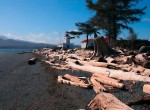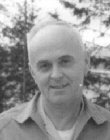In 1969 when I came on my first lighthouse at Pulteney Point it was a three man station. I was the new man on shift so I got the night shift.
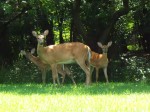
One of the first things I noticed when I came on shift were the number of deer on the lawn, even at eleven o’clock at night! They were everywhere. Pulteney Point had quite an extensive station area, and behind was dense forest.
It never failed that the deer came every night around dusk and left at daybreak. They just seemed to appear as if by magic – then one moment they were there and the next not.
I could not really sit and watch them all the time, and as I was on night shift (12 to 8 AM) they were already there when I woke up.
In the morning, as the sun started to rise we had station duties to perform which kept us inside or preoccupied so they came and they went on their own schedule.
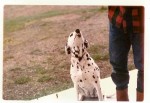
I was on Pulteney Point for three (3) years. In the second year, my wife Karen and I searched for and found a Dalmatian pup which we brought back to the lighthouse. Tricia was a riot. She had a most infectious grin! She was also very easy to train. I trained her with hand signals so that in the woods I did not have to speak and scare the animals. This was for hunting later, but also for wildlife observing. A dog can sense an animal more quickly than we humans can.
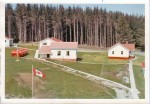
So, as Tricia started to grow, my shifts also changed as we went from a three-man station to a two-man station. Unfortunately that didn’t help me too much as my shift then went from 12 midnight until 12 noon with no overtime. Part of the government’s way of saving money!
One evening, when Tricia was well trained to hand signals I decided to explore back in the woods for the deer. A few hours before sunset Tricia and I stalked back into the woods to a small hill about a quarter mile behind the station.
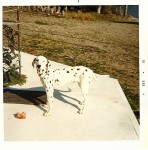
We parked ourselves below the crest of the hill and off to the side of the abundant deer trails. I dug out my binoculars and waited. And waited. And waited. Tricia not uttering even a whine.
It got dark. It got darker, but not a trace or sound of the deer. Tricia never even sensed them. I waited until two hours after dark and then headed back to the station. Maybe they weren’t coming tonight.
As I emerged from the trees, there was the whole herd, probably about twenty (20) of them eating peacefully on the lawn grass we had so carefully supplied for them. One or two looked up and I almost heard them ask “Where have you been?”

Many times I searched for their tracks, looked on the sand on the beaches, watched out the windows, but I never saw them emerge – they just appeared! It was uncanny, but because of the coastal deer’s colour, at dusk it just blended into the surroundings.
On the station we had a great big fluorescent street lamp on a lamp pole – you can see it just before the red fuel tanks in the station photo at the top. It was just like those in the city, which someone in the government had given us to see better in the dark.
It was so bright we lost all night vision, and it was sometimes mistaken by the boats for the main light as it was brighter! With this the deer showed up, but without it, they would not be seen until we stumbled over them. They never moved when I came by, and even Tricia didn’t bother them or they her as she followed me up and down the sidewalks.

Speaking of sidewalks, I think they thought of them as their toilet. Every morning it was my job to sweep the sidewalks of brown raisins!
The deer were great to see, but one of their most annoying habits was the eating of the flowers in the gardens near the houses. They didn’t like newly-emerging daffodil leaves or tulip leaves, but they did love the flowers. Wow! We have flowers coming in the garden. Next morning nothing! That is where the title comes from. I heard it a long time ago – Where Bambi goes, nothing grows!
